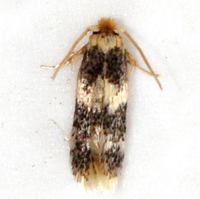Identification
Adult Markings: The following is based on the description in Wilkinson (1979). The palps are creamy white and the antenna pale grayish brown. The tuft on the front of the head is dark ochreous and the vertex darker. The eye-cap is shining white and the collar dark ochreous. The thorax is whitish and weakly lustrous. The ground color of the forewing is pale brown with bronze reflections. Each scale is grayish at the base produces a finely spotted effect which becomes more prominent distally. The fringe is whitish and iridescent silver, with varying levels of fine spotting near the base. There is a single medial fascia that is off-white. It broadens on the dorsal margin and is followed by two post-median marginal patches of the same color. The ground color and fringe of the hindwing are pale grayish white to shining silver, and the legs are pale yellowish brown with scattered metallic gray reflections. A pair of hair brushes is present dorsally on segment IV. This species resembles A. bipinnatellus that occurs in southern Florida, but has a darker ground color, smaller distal patches, and lacks an apical patch (Wilkinson 1979).
Wingspan: 4.6-5.2 mm (Wilkinson, 1979).
Adult Structural Features: Wilkinson (1979) provided illustrations and detailed descriptions of the genitalia. The following is based on his descriptions. In males, the pseuduncus is extended and weakly bilobed posteriorly. The uncus has a bridge-like sclerotization with a single medial process. The gnathos has a transverse ventral plate with a broad medial process. The dorso-lateral arms are broad and blunted terminally. The vinculum has lateral arms that are narrow with weakly sclerotized bars, and the ventral plate is very narrow. The saccus is broader than the ventral plate and markedly bilobed, with each lobe twice as long as broad at the base. The valves do not reach beyond the pseuduncus and are straight and blunted terminally. The transtillae have lateral arms that are short and narrow, ventral arms that are long and straight, and transverse bars fused to form a continuous narrow strap. The juxta is a flask-shaped spinose plate. The aedeagus is regular, equal to the length of the capsule, and has a medial orifice at the point of entry of the ductus ejaculatorius. The vesica is well defined, with cornuti as small denticles distally, and with a cup-shaped plate of minute papillae. The anellus is comprised of a pair of very large canine tooth-like spines. In the female, the colliculum is funicular and weakly sclerotised. The ductus bursae is short, expands medially and bears three fin-like plates. The accessory duct arises from the area of dilation, and is spiral proximally. The bursa copulatrix is covered proximally with scallop-shaped chains of pectinations. The signum is double, comprising two equal length bands of spinose cells with a spinose margin. The anterior apophyses are short and broad, and the posterior apophyses are narrow and approximately four times the length of the anteriores. The anal plate is large and constricted medially.
Adult ID Requirements: Identifiable from good quality photos of unworn specimens.
Immatures and Development: The host species and virtually all aspects of the larval stages are undocumented. Eiseman (2019) noted that a morphologically similar specimen from Maryland was reared from Schoenoplectus americanus (Cyperaceae), but Erik van Nieukerken reports that DNA barcodes of A. thoracealbella better match legume feeders rather than the sedge feeders.

 »
»



 »
»

